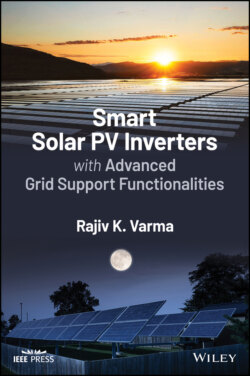Читать книгу Smart Solar PV Inverters with Advanced Grid Support Functionalities - Rajiv K. Varma - Страница 2
Table of Contents
Оглавление1 COVER
2 SERIES PAGE
3 TITLE PAGE
4 COPYRIGHT PAGE
5 DEDICATION PAGE
6 ABOUT THE AUTHOR
7 FOREWORD
8 PREFACE
9 ACKNOWLEDGMENTS
10 LIST OF ABBREVIATIONS
11 1 IMPACTS OF HIGH PENETRATION OF SOLAR PV SYSTEMS AND SMART INVERTERDEVELOPMENTS 1.1 Concepts of Reactive and Active Power Control 1.2 Challenges of High Penetration of Solar PV Systems 1.3 Development of Smart Inverters 1.4 Conclusions References
12 2 SMART INVERTER FUNCTIONS 2.1 Capability Characteristics of Distributed Energy Resource (DER) 2.2 General Considerations in Implementation of Smart Inverter Functions 2.3 Smart Inverter Functions for Reactive Power and Voltage Control 2.4 Smart Inverter Function for Voltage and Active Power Control 2.5 Low/High Voltage Ride‐Through (L/H VRT) Function 2.6 Frequency–Watt Function 2.7 Low/High Frequency Ride‐Through (L/H FRT) Function 2.8 Ramp Rate 2.9 Fast Frequency Response 2.10 Smart Inverter Functions Related to DERs Based on Energy Storage Systems 2.11 Limit Maximum Active Power Function 2.12 Set Active Power Mode 2.13 Active Power Smoothing Mode 2.14 Active Power Following Function 2.15 Prioritization of Different Functions 2.16 Emerging Functions 2.17 Summary References
13 3 MODELING AND CONTROL OF THREE‐PHASE SMART PV INVERTERS 3.1 Power Flow from a Smart Inverter System 3.2 Smart PV Inverter System 3.3 Power Circuit Constituents of Smart Inverter System 3.4 Control Circuit Constituents of Smart Inverter System 3.5 Smart Inverter Voltage Controllers 3.6 PV Plant Control 3.7 Modeling Guidelines 3.8 Summary References
14 4 PV‐STATCOM: A NEW SMART PV INVERTER AND A NEW FACTS CONTRO 4.1 Flexible AC Transmission System (FACTS) 4.2 Static Var Compensator (SVC) 4.3 Synchronous Condenser 4.4 Static Synchronous Compensator (STATCOM) 4.5 Control Modes of SVC and STATCOM 4.6 Photovoltaic‐Static Synchronous Compensator (PV‐STATCOM) 4.7 Operating Modes of PV‐STATCOM 4.8 Functions of PV‐STATCOM 4.9 Cost of Transforming an Existing Solar PV System into PV‐STATCOM 4.10 Cost of Operating a PV‐STATCOM 4.11 Summary References
15 5 PV‐STATCOM APPLICATIONS IN DISTRIBUTION SYSTEMS 5.1 Nighttime Application of PV Solar Farm as STATCOM to Regulate Grid Voltage 5.2 Increasing Wind Farm Connectivity with PV‐STATCOM 5.3 Dynamic Voltage Control by PV‐STATCOM 5.4 Enhancement of Solar Farm Connectivity by PV‐STATCOM 5.5 Reduction of Line Losses by PV‐STATCOM 5.6 Stabilization of a Remotely Located Critical Motor by PV‐STATCOM 5.7 Conclusions References
16 6 PV‐STATCOM APPLICATIONS IN TRANSMISSION SYSTEMS 6.1 Increasing Power Transmission Capacity by PV‐STATCOM 6.2 Power Oscillation Damping by PV‐STATCOM 6.3 Power Oscillation Damping with Combined Active and Reactive Power Modulation Control of PV‐STATCOM 6.4 Mitigation of Subsynchronous Resonance (SSR) in Synchronous Generator by PV‐STATCOM 6.5 Alleviation of Subsynchronous Oscillations (SSOs) in Induction‐Generator‐Based Wind Farm by PV‐STATCOM 6.6 Mitigation of Fault‐Induced Delayed Voltage Recovery (FIDVR) by PV‐STATCOM 6.7 Simultaneous Fast Frequency Control and Power Oscillation Damping by PV‐STATCOM 6.8 Conclusions References
17 7 INCREASING HOSTING CAPACITY BY SMART INVERTERS – CONCEPTS AND APPLICATIONS 7.1 Hosting Capacity of Distribution Feeders 7.2 Hosting Capacity Based on Voltage Violations 7.3 Increasing Hosting Capacity with Non Smart Inverter Techniques 7.4 Characteristics of Different Smart Inverter Functions 7.5 Factors Affecting Hosting Capacity of Distribution Feeders 7.6 Determination of Settings of Constant Power Factor Function 7.7 Impact of DER Interconnection Transformer 7.8 Determination of Smart Inverter Function Settings from Quasi‐Static Time‐Series (QSTS) Analysis 7.9 Guidelines for Selection of Smart Inverter Settings 7.10 Determination of Sites for Implementing DERs with Smart Inverter Functions 7.11 Mitigation Methods for Increasing Hosting Capacity 7.12 Increasing Hosting Capacity in Thermally Constrained Distribution Networks 7.13 Utility Simulation Studies of Smart Inverters for Increasing Hosting Capacity 7.14 Field Implementation of Smart Inverters for Increasing Hosting Capacity 7.15 Conclusions References
18 8 CONTROL COORDINATION OF SMART PV INVERTERS 8.1 Concepts of Control Coordination 8.2 Coordination of Smart Inverters with Conventional Voltage Controllers 8.3 Control Interactions – Lessons Learned from Coordination of FACTS Controllers for Voltage Control 8.4 Control Interactions Among Smart PV Inverters and their Mitigation 8.5 Study of Smart Inverter Controller Interactions 8.6 Case Study of Controller Coordination of Smart Inverters in a Realistic Distribution System 8.7 Control Coordination of PV‐STATCOM and DFIG Wind Farm for Mitigation of Subsynchronous Oscillations 8.8 Control Interactions Among Plants of Inverter Based Resources and FACTS/HVDC Controllers 8.9 Conclusions References
19 9 EMERGING TRENDS WITH SMART SOLAR PV INVERTERS 9.1 Combination of Smart PV Inverters with Battery Energy Storage Systems (BESS) 9.2 Combination of Smart PV Inverters with Electric Vehicle Charging Systems 9.3 Combination of Smart PV Inverters with Battery Energy Storage Systems (BESS) and EV Charging Systems 9.4 Grid Forming Inverter Technology 9.5 Field Demonstrations of Smart Solar PV Inverters 9.6 Potential of New Revenue Making Opportunities for Smart Solar PV Inverters 9.7 Conclusions References
20 INDEX
21 END USER LICENSE AGREEMENT
